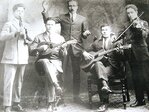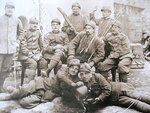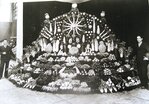



Beverly Farms, as we know it today, has a forever feel about it. It’s charming and small, with pockets of Gilded Age mansions and summer “cottages” connected to some of the great names in American history. But really, that Beverly Farms only came to be in the 19th Century, when, in 1844, the Eastern Railroad decided to extend its route from Beverly to Gloucester. That single move transformed Beverly Farms from a quiet, somewhat isolated, seaside community to a summer playground for wealthy Bostonians, fundamentally changing the town.
Local historian Nancy Coffey has been studying this evolution of Beverly Farms for more than a decade. Her considerable body of research in now being organized into a book, one that expands the story of Beverly Farms to include its year-round working class, as well as the estate workers who arrived during the era of the North Shore Gold Coast—the 1840's to the 1950’s. For Coffey, these overlooked elements complete the story of Beverly Farms, and drive a richer appreciation of the community.
Nancy Coffey was born in Beverly in 1940 and grew up on Putnam Street in North Beverly. She holds a B.A. in history from Wellesley College and a MAT (Master of Arts in Teaching) in history from Yale. In the 1970s she began volunteering at the Beverly Historical Society. In reviewing the exhibits, she noticed that there was nothing on immigrants, while the larger city of Beverly had a vibrant Italian community.
Census data showed that at the turn of the 20th century, Italians began immigrating in large numbers to Beverly Farms and working as laborers. This tracked with the many waves of immigrants—from Ireland, Italy, Poland, Russia and Lithuania, Greece, among others—that drove the rise of America’s industrial economy. This led Nancy to look into the history of Italian immigration with a hyper local lens of Beverly Farms.
She began by interviewing members of the current Italian community. This began with a friend and neighbor of Nancy’s, Frank Albano. Frank grew up in a poor Italian family in the town of Fondi, halfway between Rome and Naples.
At age 10 he began “eeling” to help support his parents and siblings. In an interview with Nancy he explained, “When I’d go home (from fishing) the whole front of my house — full of people, waiting for me to come with the eels. Six cents a pound.”
He came to Beverly Farms in about 1912 when he was 13 years old. He got a job working as a teenaged laborer at the Spaulding Gardens, today the site of The Glen Urquhart School. Though he began as a laborer. He told Nancy that when he arrived in Beverly Farms, he knew he would never go back to Italy. There was nothing for him there.
But he did go back, in 1915 to visit his mother. And he was immediately drafted into the Italian Army during WWI. After the war, in 1920, Frank was one of the first men to return to Beverly Farms. He was hired to work as a greenhouse man at the West Manchester estate of Albert Burrage. He took English language classes at night and joined the Beverly Farms Orchestra where he played the clarinet. Later, he found work back at the Spaulding Gardens. Though he began as a laborer, in time Frank became a skilled gardener.
Their conversations became more detailed, and Nancy understood she was chronicling stories, important immigrant stories, that may otherwise be completely lost.
One such story came when during an interview Frank mentioned that upon immigrating to Beverly Farms, he first lived at a shanty town in The Farms known as “The Crush.”
Nancy had no idea what he was talking about.
As it turned out, an early Beverly Farms industry (besides farming) was quarrying of granite. These quarries were vertical, not dug. As a result, there were huge quarry cliffs and the granite liberated from the quarries was crushed in a large machine simply called a “crusher.” And it was here, in the woods by the quarries that Italian workmen built simple homes, living together in their made community, “The Crush.”
Frank lived there with his brother. The dwellings were wooden with potbellied stoves inside for warmth. They cooked over fires outside, year-round.
Frank took Nancy to see The Crush in 2006. There were the remains of a house and well foundations. She also found a blue enameled coffee pot.
Nancy knew that Frank’s story and those of immigrant families from Italy, as well as other countries, had to be shared.
As she was not born in Beverly Farms (though she had lived there for 30 years) Coffey worried that she might experience resistance to writing a town history. So she created a quiz about Beverly Farms and distributed it to residents (including whether a shanty town ever existed in Beverly Farms).
She revealed the results during a popular talk at the Beverly Farms Library. Having piqued the crowd’s interest, Nancy introduced the project and put out a call for stories. In time many other immigrants came forward with their experiences. What began as interviews with Frank Albano expanded to other families, other stories, other crafts and cultures and traditions. Those stories began to fill in the gaps, to paint a greater picture of Beverly Farms.
Her work is notable not only for its academic importance, but also for its inclusion of these immigrant families and their contributions and experiences which are an essential part of the historical fabric of “The Farms.”
We look forward to her book.